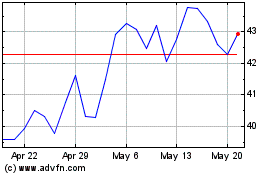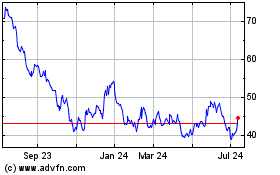Can Solar ETFs Continue Their Bull Run? - ETF News And Commentary
February 12 2013 - 7:35AM
Zacks
The global solar industry seems to be rebounding from its hard
hit 2012 performance with the resolution of the U.S. fiscal cliff
and the uptick in the price of polysilicon – the key raw material
in photovoltaic solar panels. Consolidation and specialization are
the two keys elements for the development of the industry.
With that being said, solar ETFs could perform better this year,
providing investors with solid gains to extend their rally once
more. The Guggenheim Solar ETF
(TAN) was up
13.5% while the other ETF tracking the space, the Market
Vectors Solar Energy ETF
(KWT), performed
slightly worse (but still very respectable), adding 11.6%
year-to-date.
Though these gains are not enough to make up for the past
losses, it is performing better in the energy space like the other
alternatives ETFs (read: Solar ETF Rally Continues). While these
two funds focus on small cap companies and charge 65 bps in annual
fees from investors, they are still different from each other.
TAN tracks the MAC Global Solar Energy Index which offers
exposure to companies in some aspects of the solar power
industry.
These include companies that produce products for end-users,
manufactures of solar panels, and even firms that are engaged in
solar power system sales, distribution, installation, integration
or financing; and companies that specialize in selling electricity
derived from solar power.
The index also includes companies that are not exclusively
focused on solar power although it gives these firms a lower
weighting than their pure-play peers.
The product holds 27 securities in the basket with heavy
weightings dedicated to GCL-Poly Energy Holdings,
First Solar
(FSLR) and Memc
Electric Materials
(WFR). From a country
perspective, the U.S. makes up about two-fifths of total assets
while China and Germany comprise 29.7% and 11.6%, respectively, and
give a decent exposure.
Meanwhile, the Market Vectors product tracks the Ardour Solar
Energy Index. The benchmark is a rules-based, modified
global-capitalization-weighted, float-adjusted index intended to
give investors a means of tracking the overall performance of a
global universe of listed companies engaged in the solar energy
industry.
The Index provides exposure to publicly traded companies from
around the world that derive at least 66% of their revenues from
solar energy. On a weighted basis, the index constituents derive in
excess of 90% of their revenues from solar energy.
The basket includes 263 securities with top weightings going
towards GCL-Poly Energy, WFR and FSLR. American securities dominate
the portfolio with 35% going to the U.S. while China accounts for
26% of the assets. Taiwan and UK also make up a nice mix with 14%
share each in the basket (see more ETFs in the Zacks ETF
Center).
Bright Future Ahead
The solar industry is evolving rapidly with China leading the
way (read: Finally Some Good News for Solar ETFs?). Previously,
Chinese solar companies had unlimited opportunities for financing
which helped them to ramp up supply and trim marginal costs to an
extremely low level.
This led to accusations of dumping, whereby Chinese companies
sell their products at a loss in order to push the less subsidized
American firms out of business.
With the decline in the cost of developing solar technologies,
this situation seems to be changing as the Chinese government is
taking several initiatives to boost growth in the space. The
country is currently focusing on untapped domestic markets, which
have become one of the world’s biggest areas for solar energy
development.
China would be pumping more into the solar space. The nation
would be adding another $1.1 billion in subsidies to the space,
doubling the government’s investment in the sector. Further, solar
companies are now able to obtain cheap long-term financing of up to
100%, without any guarantees, from Beijing.
These efforts would definitely reflate the important Chinese
export-focused solar market that has been hit by excess capacity
and waning foreign demand (read: Is the China ETF Ready to
Soar?).
Beyond this, the Middle East solar industry is also a boon to
the global solar power growth as the region intends to boost solar
power projects worth about $6.8 billion which are currently
underway in the UAE, Kuwait, Oman, Egypt, Jordan and Morocco.
Bottom Line
Solar ETFs have still been terrible performers over the long
term, even when taking into account the recent strength. Though the
broad solar sector remains risky, the space could be a bigger
player in the years to come. Investors seeking exposure to the
solar power space could tap the current opportunities as the recent
rally could (hopefully) be an end point to the bearish
trend.
Want the latest recommendations from Zacks Investment Research?
Today, you can download 7 Best Stocks for the Next 30
Days. Click to get this free report >>
FIRST SOLAR INC (FSLR): Free Stock Analysis Report
MKT VEC SOLAR (KWT): ETF Research Reports
GUGG-SOLAR (TAN): ETF Research Reports
MEMC ELEC MATRL (WFR): Free Stock Analysis Report
To read this article on Zacks.com click here.
Zacks Investment Research
Want the latest recommendations from Zacks Investment Research?
Today, you can download 7 Best Stocks for the Next 30 Days. Click
to get this free report
Invesco Solar ETF (AMEX:TAN)
Historical Stock Chart
From Apr 2024 to May 2024

Invesco Solar ETF (AMEX:TAN)
Historical Stock Chart
From May 2023 to May 2024
